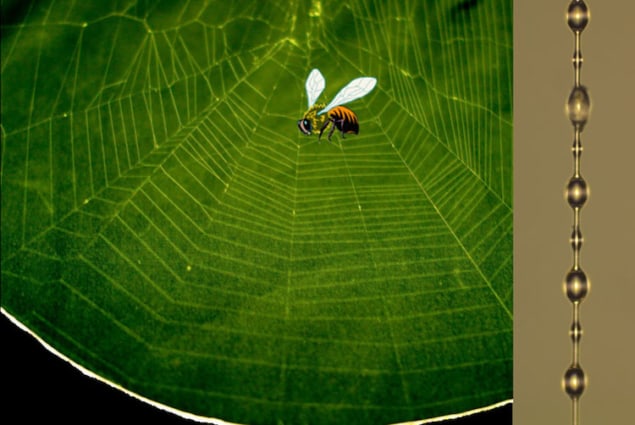
How can spider webs withstand large impacts while remaining sensitive enough to detect and trap small flying insects? Researchers in China, the US and Australia say they may now have solved this mystery. Their new findings will not only help us better understand why spider webs are so robust but they could also help in the development of new types of impact-resistant structures for engineering applications.
Almost all biological materials have evolved exquisite structures perfectly adapted to their function, explain the researchers, who are led by Xi-Qiao-Feng of Tsinghua University and Huajian Gao of Brown University, Rhode Island. Some well-known examples include silkworm cocoons, seashells and sponge endoskeletons. Spider webs are particularly impressive since they are not only lightweight, but are also strong and elastic. As such, they are able to withstand loads from things like predator impacts, gusts of wind and raindrops.
These remarkable properties come from the fact that spiders can spin different types of silks, each with very different mechanical properties, but which work in synergy. Radial silk, for example, made of major ampullate threads, is stiff and supports the frame of the web. Spiral silk, on the other hand, which the spider generates from its flagelliform gland, is more flexible and soft. And, while radial silk is smooth and non-sticky, spiral silk threads are coated with a thin layer of glue. Thanks to Rayleigh instability, this coating breaks into uniformly distributed droplets, forming a unique bead-chain.
Uniform energy absorption
Feng, Gao and colleagues have now found that the mechanical properties of spiral silk vary significantly along the radial spokes that extend outwards from the centre of a web. These functional gradients are present regardless of thread thickness, the size of the web or the characteristics of an individual spider and make the web resistant to impacts at any point on its structure, say the researchers. What is more, thanks to the silk’s optimal mechanical properties, a web can absorb energy almost uniformly everywhere.
The researchers obtained their results by studying webs spun on special wooden frames by Araneus ventricosus spiders in their lab. They examined the silk threads under a polarized optical microscope and measured the diameter of each spiral and radial silk thread at least five times. They then used averaged diameters to calculate the tensile stress of the threads using a uniaxial nanomechanical tensile testing machine that has a load resolution of 50 nM and an extension resolution of 34 nm. These tests allowed them to calculate the threads’ strength and elasticity. They also measured the number density of the glue droplets on the spiral silks as the spiders constructed their webs and connected the web spokes.

Wicked membranes mimic ultrastretchable spider silk
The team performed finite element simulations too to study how the webs absorb energy. The 2D orb web model used in their simulations consists of 10 radial threads of 30 cm in diameter and 10 spiral threads. The radial silks are distributed uniformly with an angle of 36° between any two neighbouring silk threads while the spiral silks are evenly spaced 15 mm apart. To simplify matters, they assumed that both radial and spiral silks are linear elastic and that a flying insect, for example, induces a concentrated force of 50 μN perpendicular to the web plane. They calculated the stress experienced by the web and by how much it displaces when the insect lands on different silks in the web.
Spurred on by their findings, the researchers, reporting their work in Applied Physics Letters 10.1063/1.5039710, say that they now plan to look into the “striking dynamics” of spider webs during prey capture. “The principle gleaned from our study could also offer us insights to designing impact-resistant structures,” they say.



